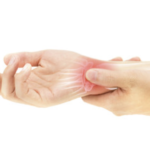Most office workers spend their days at their desks. After eight hours of typing on your keyboard and clicking a mouse, your hands and wrists might start to ache. And while office jobs don’t seem particularly dangerous besides sometimes being a bit tedious, every office worker is at risk of common office injuries.
You might not even notice how:
- The lower back becomes sore;
- Your eyes lose focus;
- Legs get numb and stiff;
- Shoulders tense up;
- Or wrists start to hurt.
Wrist trauma at work is common and can strike everyone. And one of the biggest culprits is carpal tunnel syndrome. In this article, we’ll give you an overview of this silent office worker killer and 5 ways to prevent it.
What is carpal tunnel syndrome?
Carpal tunnel syndrome is an inflammation in the tissue surrounding the median nerve. The median nerve is responsible for wrist and finger mobility and sensory abilities. When the tissue gets inflamed and swells, it pressures the nerve and blocks it from functioning properly.
The most common causes of carpal tunnel syndrome are:
- Previous wrist injury;
- Hormonal changes during menopause, pregnancy, or when the thyroid gland dysfunctions;
- Diseases like arthritis and diabetes;
- Obesity;
- Repetitive wrist movement.
Office workers are prone to carpal tunnel syndrome because they do a lot of repetitive movements with their wrists, like typing, writing, and using a mouse. Overworked ligaments and muscles might swell up and start pressuring the nerve.
Carpal tunnel syndrome at work: symptoms and diagnosis
Just because your wrists hurt, it doesn’t mean you have CTS. Other conditions that can cause wrist pain are:
- Injury
- Osteoarthritis
- Rheumatoid arthritis
- Ganglion cysts
- Kienbock disease
Carpal tunnel syndrome usually presents itself with a tingling sensation in your wrist and fingers. It then progresses to:
- Numbness and weakness in your grip and fingers;
- Burning sensation in your wrist and fingers;
- Swelling of the fingers;
- Pain and discomfort even when the wrist is relaxed.
If you believe you might have carpal tunnel syndrome, you should immediately consult with your doctor. Mild cases can be solved with small lifestyle changes like wrist support rest, exercises for the wrists, or anti-inflammatory medication. However, if you ignore the first signs, the condition might require surgery to remove inflamed tissue.
When you go to a doctor, they usually diagnose CTS by evaluating symptoms and measuring muscle and nerve response to triggers. We prepared a guide on carpal tunnel syndrome evaluation and diagnosis.
5 ways to prevent carpal tunnel syndrome at work
Although CTS is common, there are ways to prevent it and protect your wrists. In the infographic below, you can find 5 sure-fire ways to protect your wrists from carpal tunnel syndrome at work.

Wrists support
Wrist support like wrist rests, keyboard and mouse rests, or support bands are crucial ergonomic office parts. Wrist support helps your wrists stay at the right angle without pressing the nerves too much.
Even if you don’t suffer from wrist pain, it’s worth trying a wrist rest to prevent future traumas and discomfort. Uppo ergonomic wrist support band is designed for agile workers. The lightweight and durable wristband stays on your wrist the whole time you switch between the keyboard and mouse. You can sit at your desk or get comfortable on a couch with a laptop, it doesn’t matter because Uppo keeps your wrist in place wherever you are.
Exercise
Being active is crucial, but often, we forget to exercise our wrists. Even a few minutes of simple stretches can make a significant difference. You can try shaking your wrists, stretching your arms and bending the wrists up and down, or clenching a stress ball. Movement relaxes your muscles and ligaments, reducing swelling and discomfort.
Avoid repetitive movements
When you notice that you spent a few hours typing on your computer, writing, or using a mouse, change your movement. The repetitive movement puts a lot of pressure on your carpal tunnel, which can cause inflammation. Instead, try to limit your time using a mouse or a touchpad and switch to keyboard combinations, stretch your arms, or just take a break.
Take breaks
Breaks are good for your concentration and working performance. It’s better to take short breaks (5-10 mins) every hour than to take longer breaks. The longer the break, the longer it takes to focus back on work. But short breaks like standing up and going to a bathroom or looking out the window can help your eyes, back, legs, and wrists relax.
Keep warm
When the office is full of people with different needs, finding the right temperature that fits everyone can sometimes be challenging. Whether it’s a low temperature outside or your colleagues like to lower the air conditioner settings, try to keep warm. Cold muscles are more prone to injury and inflammation. If your hands and wrists are always cold and you do a lot of repetitive movement, they are more likely to develop pain.
You can keep warm by putting on special wrist warmers or a wrist support band that keeps them warm and at the right angle.
Uppo wrist support bands for pain-free work
Don’t let wrist pain steal the joy out of your work. Uppo wrist support band is an excellent choice to prevent carpal tunnel syndrome and relieve the pain if you already have it. We designed Uppo based on our experience as office workers. A light and breathable fabric wraps softly on your wrists and stays the whole time you’re working. A gel-filled padding keeps your wrist in a relaxed position and reduces tension. Choose from Cave Black, Fire Red, Electric Blue, and Dark Grey. Try it now!


